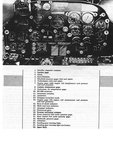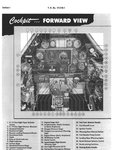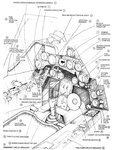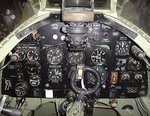Navigation
Install the app
How to install the app on iOS
Follow along with the video below to see how to install our site as a web app on your home screen.
Note: This feature may not be available in some browsers.
More options
You are using an out of date browser. It may not display this or other websites correctly.
You should upgrade or use an alternative browser.
You should upgrade or use an alternative browser.
Best - worst cockpits
- Thread starter AL Schlageter
- Start date
Ad: This forum contains affiliate links to products on Amazon and eBay. More information in Terms and rules
More options
Who Replied?both the 109 and Spit are to small for anyone of size in my personal opinion after sitting in both . Made for pygmies
Plenty of leg room for Douglas Bader!
I have never sat in a Spitfire cockpit or a P-38 cockpit but I would probably have to say that the worst had to be the Spitfire and the Bf 109. Small and cramped and the vis was not that great even though later Spits rectified the vis problem.
FLYBOYJ
"THE GREAT GAZOO"
I've sat in "White 14" (Bf 109) a P-51, P-38, T-33 (flown in it from the rear) and F-86. The 109 was definitely a bet cramped and the visibility was poor. To me all the rest were about the same as far as comfort. In the P-38 the view from the bottom left or right rear was clearly obstructed by the booms - something mentioned all the time. Although I'm a P-38 fan, all the reports about the P-38's cockpit layout being poor is pure BS. Below are some instrument panel layouts - see for your self there isn't much differance. I do know on the P-38 pilot's complained that the mike switch on the yoke interfered with the drop tank switch.
Bottom line - compare the layout of the instruments, they are all very similar on where certain instruments are located.
From top to bottom - P-38, P-51, Fw 190 and Spitfire
Bottom line - compare the layout of the instruments, they are all very similar on where certain instruments are located.
From top to bottom - P-38, P-51, Fw 190 and Spitfire
Attachments
Hi Flyboyj,
>From top to bottom
A forum-technical question: How do I get the pictures arranged vertically in the forum? On my screen, they are arranged horizontally, which makes it very difficulty to read the text in threads once a couple of pictures have been posted is a single post ...
I'd be greatly thankful for any hint you might have!
Regards,
Henning (HoHun)
>From top to bottom
A forum-technical question: How do I get the pictures arranged vertically in the forum? On my screen, they are arranged horizontally, which makes it very difficulty to read the text in threads once a couple of pictures have been posted is a single post ...
I'd be greatly thankful for any hint you might have!
Regards,
Henning (HoHun)
davparlr
Senior Master Sergeant
you forgot the most important one autopilot
Oh yeah! Shouldn't forget that!
Glider
Major
I think that one of the worst cockpits must be the He111. In certain conditions the glased nose caused a hall of mirrors effect and the pilot couldn't see a thing. Such was the problem, the pilots seat could be raised and his head would appear out of the top of the cockpit with a window poping up in front of him to deflect the slipstream, enabling him to see for landing.
FLYBOYJ
"THE GREAT GAZOO"
Hi Flyboyj,
>From top to bottom
A forum-technical question: How do I get the pictures arranged vertically in the forum? On my screen, they are arranged horizontally, which makes it very difficulty to read the text in threads once a couple of pictures have been posted is a single post ...
I'd be greatly thankful for any hint you might have!
Regards,
Henning (HoHun)
When I did the download they just arranged that way - I think if they are above a certain size they automatically go horizontal. Maybe Eric has some info on this.
renrich
Chief Master Sergeant
The knock I heard on the F4U cockpit was that a short pilot had a difficult time because the chief test pilot on the Corsair was 6 ft 4 in. and Charles Lindberg said that the visibility forward in the early Corsair was no worse than that of the "Spirit of Saint Louis"
and Charles Lindberg said that the visibility forward in the early Corsair was no worse than that of the "Spirit of Saint Louis"
Glider
Major
Another poor one would be the Me110. Some of the engine instruments were mounted on the engines. How on earth they managed in bad weather is a bit of a mystery to me.
The Basket
Senior Master Sergeant
- 3,712
- Jun 27, 2007
The Spit was a bit better than the 109 because of the canopy. The Hurricane was quite roomy in comparison.
The sliding bulged hood was better than the 109s bath tub and could be opened in flight. The Spit having more headroom and a bit better visibility.
a bit off time but the F-86 cockpit looks perfect. Visibilty superb.
The sliding bulged hood was better than the 109s bath tub and could be opened in flight. The Spit having more headroom and a bit better visibility.
a bit off time but the F-86 cockpit looks perfect. Visibilty superb.
Glider
Major
Good point and its worth remembering that some P51B/C were modified to a Spit type canopy.The Spit was a bit better than the 109 because of the canopy. .
Kurfürst
Staff Sergeant
The Spit was a bit better than the 109 because of the canopy. The Hurricane was quite roomy in comparison.
The sliding bulged hood was better than the 109s bath tub and could be opened in flight. The Spit having more headroom and a bit better visibility.
a bit off time but the F-86 cockpit looks perfect. Visibilty superb.
This is the Malcolm hood of the Spit IX, plotted against the 109Es canopy.
The 109`s canopy dimensions were practically the same through the series, and you can follow the Spit`s canopy size in all three steps it had :
a, The smallest dimensioned one being the original canopy first used
b, The slight bulge on the top showing the slight bulge that was added to the top
c, The final Malcolm canopy`s side bulges that were added later, late 1941 or ealry 1942 IIRC?
The Basket
Senior Master Sergeant
- 3,712
- Jun 27, 2007
I remember watching a documentry about the Spit and it had Sqn Ldr Paul Day who flew Spitfires in the BBMF a few years ago.
He said that the Spitfire had its foibiles such as poor visibility and having to change hands on take-off to retract undercarriage.
He happened to sit in the famous Black 6...which is a Bf 109G-2 which was flying at the time. He considered the instruments to be good and logical but was scathing about the cockpit. He thought it far too small and the hood restrictive. His view was not exactly positive. He went on about the breech of the cannon been between his legs and the fact that the stick was fouled by his legs so he couldn't move the stick freely. He considered it 100% worse than the Spit.
The original Spit hood was changed due to more headroom for taller pilots rather than extra visibility although it did that too.
He said that the Spitfire had its foibiles such as poor visibility and having to change hands on take-off to retract undercarriage.
He happened to sit in the famous Black 6...which is a Bf 109G-2 which was flying at the time. He considered the instruments to be good and logical but was scathing about the cockpit. He thought it far too small and the hood restrictive. His view was not exactly positive. He went on about the breech of the cannon been between his legs and the fact that the stick was fouled by his legs so he couldn't move the stick freely. He considered it 100% worse than the Spit.
The original Spit hood was changed due to more headroom for taller pilots rather than extra visibility although it did that too.
P-47, Me-262, P-51, FW-190, Spitfire Tempest come to my mind as the most comfortable when talking about cockpits. The Bf-109 cockpit is cramped to some degree, but vision in the later versions is actually great and the small cockpit in no way prevents you from achieving the job swiftly and effectively.
The Basket
Senior Master Sergeant
- 3,712
- Jun 27, 2007
The Erla hood or Galland hood is no substitute for a bubble.
The P-38 must be one of the worst cockpit layouts of WWII. Im a HUGE P-38 fan, but that was one of its low spots. It had a great forward view, but to the sides and back was hampered by the engine, wings and boom. Also, its one of the few Army aircraft that never addopted a 1 peace bubble frame, like the P-51 or P-47. Then there was the layout. The yoke frame blocked a lot of vital fuse switches needed during combat. Also, the landing gear lever was poorly placed, and many other poor design aspects that made flying it more complex then other twins, let alone single engine fighters. Also, there was that cold cockpit problem not solved till the L series. Before that, the only warm air into the cockpit was drawn from the surface of the turbo-super, passed though the wing, and spilled into the cockpit for window defrosting, VS having a big V-12 or P&W in front of you keeping you warm.
It could of done with a re-design big time.
Here are comments from a P-38 in reguards to its complexities.
"As a typical case to demonstrate my point, let us assume that we have a pilot fresh out of flying school with about a total of twenty-five hours in a P-38, starting out on a combat mission. He is on a deep ramrod, penetration and target support to maximum endurance. He is cruising along with his power set at maximum economy. He is pulling 31" Hg and 2100 RPM. He is auto lean and running on external tanks. His gun heater is off to relieve the load on his generator, which frequently gives out (under sustained heavy load). His sight is off to save burning out the bulb. His combat switch may or may not be on. Flying along in this condition, he suddenly gets "bounced", what to do flashes through his mind. He must turn, he must increase power and get rid of those external tanks and get on his main. So, he reaches down and turns two stiff, difficult gas switches {valves} to main - turns on his drop tank switches, presses his release button, puts the mixture to auto rich (two separate and clumsy operations), increases his RPM, increases his manifold pressure, turns on his gun heater switch (which he must feel for and cannot possibly see), turns on his combat switch and he is ready to fight. At this point, he has probably been shot down or he has done one of several things wrong. Most common error is to push the throttles wide open before increasing RPM. This causes detonation and subsequent engine failure. Or, he forgets to switch back to auto rich, and gets excessive cylinder head temperature with subsequent engine failure.
In my limited experience with a P-38 group, we have lost as least four (4) pilots, who when bounced, took no immediate evasive action. The logical assumption is that they were so busy in the cockpit, trying to get organized that they were shot down before they could get going."
A lot of those switches and valves are very hard to get to. Fuel switch is between the seat and the left cockpit wall, and below an electrical box. You cant even see them in any cockpit photo's! It was a very poor pit, and just think of how much better the aircraft it would be if it had a well laid out cockpit.
It could of done with a re-design big time.
Here are comments from a P-38 in reguards to its complexities.
"As a typical case to demonstrate my point, let us assume that we have a pilot fresh out of flying school with about a total of twenty-five hours in a P-38, starting out on a combat mission. He is on a deep ramrod, penetration and target support to maximum endurance. He is cruising along with his power set at maximum economy. He is pulling 31" Hg and 2100 RPM. He is auto lean and running on external tanks. His gun heater is off to relieve the load on his generator, which frequently gives out (under sustained heavy load). His sight is off to save burning out the bulb. His combat switch may or may not be on. Flying along in this condition, he suddenly gets "bounced", what to do flashes through his mind. He must turn, he must increase power and get rid of those external tanks and get on his main. So, he reaches down and turns two stiff, difficult gas switches {valves} to main - turns on his drop tank switches, presses his release button, puts the mixture to auto rich (two separate and clumsy operations), increases his RPM, increases his manifold pressure, turns on his gun heater switch (which he must feel for and cannot possibly see), turns on his combat switch and he is ready to fight. At this point, he has probably been shot down or he has done one of several things wrong. Most common error is to push the throttles wide open before increasing RPM. This causes detonation and subsequent engine failure. Or, he forgets to switch back to auto rich, and gets excessive cylinder head temperature with subsequent engine failure.
In my limited experience with a P-38 group, we have lost as least four (4) pilots, who when bounced, took no immediate evasive action. The logical assumption is that they were so busy in the cockpit, trying to get organized that they were shot down before they could get going."
A lot of those switches and valves are very hard to get to. Fuel switch is between the seat and the left cockpit wall, and below an electrical box. You cant even see them in any cockpit photo's! It was a very poor pit, and just think of how much better the aircraft it would be if it had a well laid out cockpit.
FLYBOYJ
"THE GREAT GAZOO"
The P-38 cockpit was probably set up at the direction of the AAF who never had to deal with a tri-cycle configured twin engine fighter. I've sat in a P-38 and flown twin engine aircraft - the only problem with the P-38s landing gear lever is id doesn't have a "wheel" on it so you could grab it without lighting and identify it as a landing gear lever - something thought of years later...The P-38 must be one of the worst cockpit layouts of WWII. Im a HUGE P-38 fan, but that was one of its low spots. It had a great forward view, but to the sides and back was hampered by the engine, wings and boom. Also, its one of the few Army aircraft that never addopted a 1 peace bubble frame, like the P-51 or P-47. Then there was the layout. The yoke frame blocked a lot of vital fuse switches needed during combat. Also, the landing gear lever was poorly placed, and many other poor design aspects that made flying it more complex then other twins, let alone single engine fighters. Also, there was that cold cockpit problem not solved till the L series. Before that, the only warm air into the cockpit was drawn from the surface of the turbo-super, passed though the wing, and spilled into the cockpit for window defrosting, VS having a big V-12 or P&W in front of you keeping you warm.
It could of done with a re-design big time.
Confessions of a low time multi-engine pilot....Here are comments from a P-38 in reguards to its complexities.
"As a typical case to demonstrate my point, let us assume that we have a pilot fresh out of flying school with about a total of twenty-five hours in a P-38, starting out on a combat mission. He is on a deep ramrod, penetration and target support to maximum endurance. He is cruising along with his power set at maximum economy. He is pulling 31" Hg and 2100 RPM. He is auto lean and running on external tanks. His gun heater is off to relieve the load on his generator, which frequently gives out (under sustained heavy load). His sight is off to save burning out the bulb. His combat switch may or may not be on. Flying along in this condition, he suddenly gets "bounced", what to do flashes through his mind. He must turn, he must increase power and get rid of those external tanks and get on his main. So, he reaches down and turns two stiff, difficult gas switches {valves} to main - turns on his drop tank switches, presses his release button, puts the mixture to auto rich (two separate and clumsy operations), increases his RPM, increases his manifold pressure, turns on his gun heater switch (which he must feel for and cannot possibly see), turns on his combat switch and he is ready to fight. At this point, he has probably been shot down or he has done one of several things wrong. Most common error is to push the throttles wide open before increasing RPM. This causes detonation and subsequent engine failure. Or, he forgets to switch back to auto rich, and gets excessive cylinder head temperature with subsequent engine failure.
In my limited experience with a P-38 group, we have lost as least four (4) pilots, who when bounced, took no immediate evasive action. The logical assumption is that they were so busy in the cockpit, trying to get organized that they were shot down before they could get going."
A lot of those switches and valves are very hard to get to. Fuel switch is between the seat and the left cockpit wall, and below an electrical box. You cant even see them in any cockpit photo's! It was a very poor pit, and just think of how much better the aircraft it would be if it had a well laid out cockpit.
Users who are viewing this thread
Total: 1 (members: 0, guests: 1)




